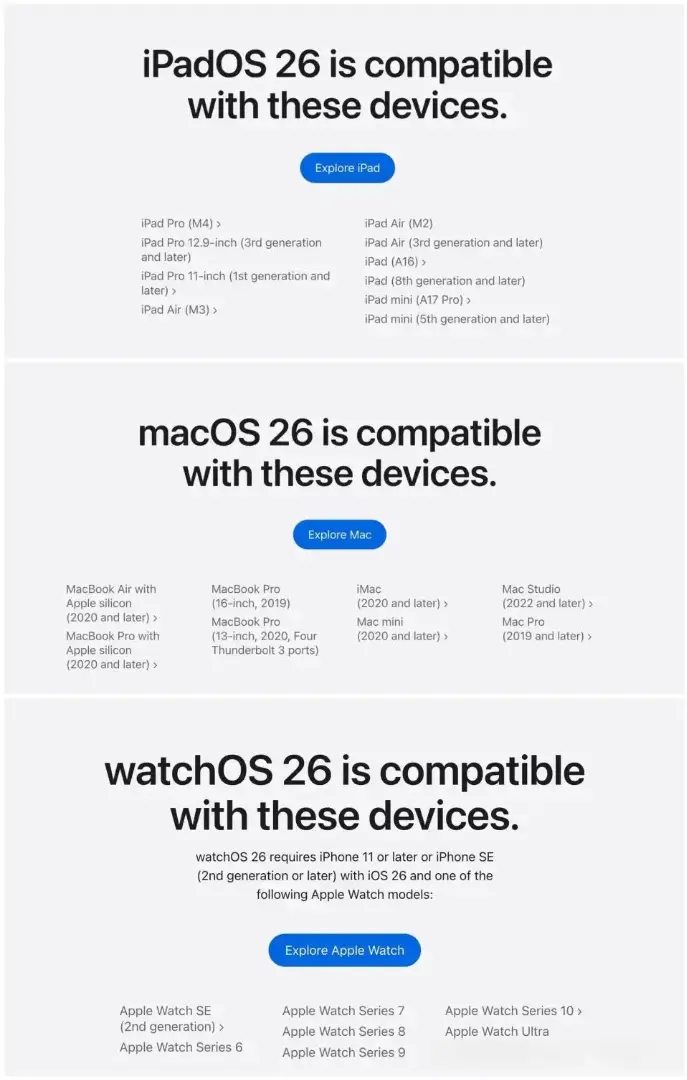Apple’s 2025 Worldwide Developers Conference (WWDC) has arrived, not only announcing the start of a new era for iOS, iPadOS, watchOS, and macOS, but also with disruptive technological innovations and a clear hardware iteration roadmap.
Among them, the emergence of iOS 26 (formerly known as iOS 19), officially called the biggest change since iOS 7 after 12 years of hard work, marks the arrival of a new era.
The key point is that after the release of this system, the series of changes and upgrade lists about the system itself are very clear, and Apple fans can also learn about it.
The upgrade list in particular directly covers multiple different platforms, so let’s make it short and take a look at how many changes there are.

It is important to understand that the release of iOS 26 is not just a simple version iteration, it brings two major technological innovations: the revolutionary “Liquid Glass” display technology and a deeply integrated, comprehensive next-generation AI engine.
Although the indian version still cannot experience AI features, it has laid the foundation for future development, mainly the former, which will indeed change the user’s visual effects.
However, the price of the dual technological revolution is bound to be a significant increase in the hardware threshold. Apple officially announced at WWDC: iPhone XS, iPhone XS Max and iPhone XR, the three classic models released in 2018, will stop at iOS 18.
This marks the official end of the iPhone era equipped with the A12 Bionic chip. In an official statement, Apple emphasized that the new system’s stringent requirements on mobile phone performance were the core reason for making this “difficult decision.”

The complete list of iOS 26 supported devices is also very clear, such as the new flagships: iPhone 16e, iPhone 16, iPhone 16 Plus, iPhone 16 Pro, iPhone 16 Pro Max.
In recent years, the main forces are iPhone 15, iPhone 15 Plus, iPhone 15 Pro, and iPhone 15 Pro Max; the ones with strong performance are iPhone 14, iPhone 14 Plus, iPhone 14 Pro, and iPhone 14 Pro Max.
Then there are the classic models: iPhone 13, iPhone 13 mini, iPhone 13 Pro, iPhone 13 Pro Max; iPhone 12, iPhone 12 mini, iPhone 12 Pro, iPhone 12 Pro Max.
Finally, there are the entry-level choices: iPhone 11, iPhone 11 Pro, iPhone 11 Pro Max, and iPhone SE (second generation and subsequent models).

This list clearly outlines Apple’s hardware bottom line for users who continue to upgrade: devices equipped with A13 Bionic chips (iPhone 11 series) and newer processors.
As the “gatekeeper”, the computing power provided by the iPhone 11 series’ A13 processor has become a watershed for experiencing new AI and graphics technologies.
However, the iOS 26 Beta version has been updated. According to the feedback from most Apple fans, it is not recommended to upgrade because of the frequent lags.
Perhaps we have to wait for further revelations to make the user experience better. At this stage, it is recommended to wait and see and stay with the old version.

In addition to the upgrade list of iOS 26, the synergy of Apple’s ecosystem is also highlighted in this update, and the new systems of other platforms also clarify their respective hardware boundaries.
For example, the update focus of watchOS 26 is to ensure the best experience for newer devices. The support list starts with Apple Watch Series 6, and subsequent Series 7, 8, 9, 10, as well as Apple Watch SE (second generation) and Apple Watch Ultra / Ultra 2 are all included.
However, users of Series 5 and earlier models will not be able to enjoy the health monitoring improvements, watch face customization, and performance optimizations brought by the new system.
This is also because performance and release time have become very critical factors. For users who want to experience it, they can only switch to new products to experience it.

The adaptation strategy of iPadOS 26 highlights Apple’s reliance on the performance of self-developed chips. Supported devices include iPad Pro (M4 chip), iPad Pro 12.9 inches (third generation and subsequent), and iPad Pro 11 inches (first generation and subsequent).
Then it includes iPad Air (M2 chip and later), iPad Air (third generation and later), iPad (models equipped with A16 chip and later), and iPad (eighth generation and later – note that the seventh generation is excluded).
As well as iPad mini (equipped with A17 Pro chip models and later), iPad mini (5th generation and later – also pay attention to the restrictions on early models).
As for the iPad (7th generation) equipped with A10 Fusion chip, it is the only model that supports iPadOS 18 but cannot be upgraded to iPadOS 26. The upgrade cycle of low-cost iPads has reached its limit here.

In addition, the hardware support policy of macOS 26 (named Sequoia) continues Apple’s determination to transition to Apple Silicon, while providing final support for some high-end Intel models.
Although the increase in product hardware thresholds has stopped some classic devices from being marketed, it also clearly points out the reality that performance and experience cannot be achieved at the same time. Users also need to decide whether to upgrade based on their own needs.
So the question is, are your models on the list? Let’s talk about it together.


